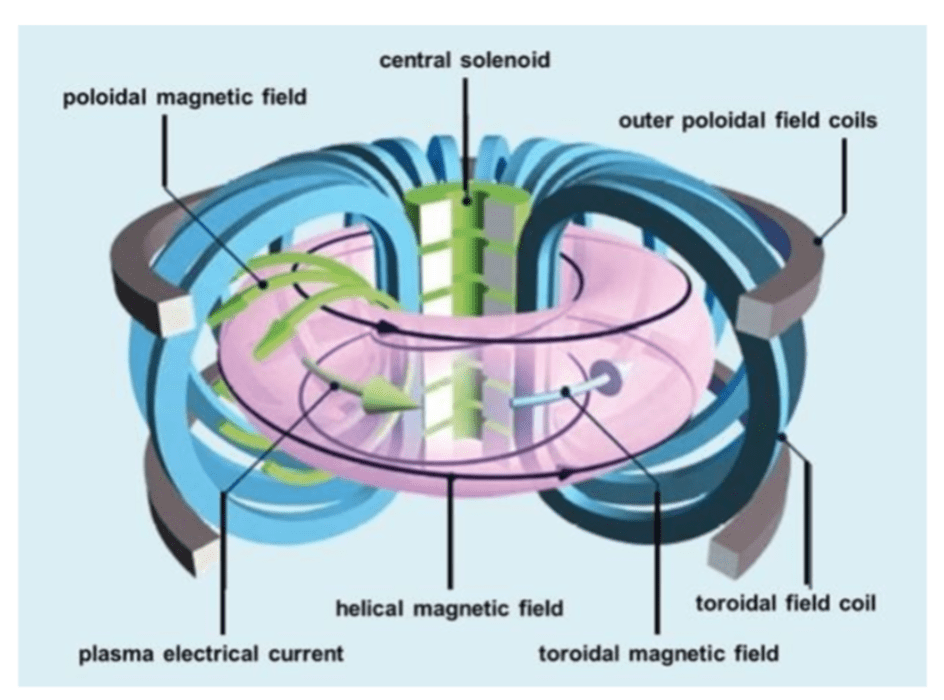News Excerpt: Energy Singularity, a China-based fusion energy company, has developed the world’s first high-temperature superconducting tokamak device named ‘HH70.’
More about the device:
- Located in Shanghai, this device, termed an "artificial sun," operates on the principle of nuclear fusion of hydrogen atoms, similar to the sun’s energy production process.
- This marks China's significant entry into the fusion-based clean energy market.

What is a Tokamak?
- A tokamak is a machine that uses magnets to control the nuclear fusion of hydrogen atoms in superheated plasma, resulting in the creation of helium and the release of enormous energy without generating nuclear waste, unlike nuclear fission.
- The HH70 was designed and installed in under two years, with plans for a second-generation tokamak by 2027 and a technology demonstrator by 2030.
Significance of Nuclear Fusion
- Nuclear fusion in tokamaks is vital because fusion based nuclear reactors do not produce nuclear waste which is common in fission based nuclear reactors.
- This clean energy source could revolutionise the energy sector.
China Achieves Net Energy Gain
- Nuclear scientists in several countries, including China, have successfully generated a net energy gain using tokamak technology, demonstrating its potential for sustainable energy production.
- Recently, the Korea Institute of Fusion Energy’s (KFE) Korea Superconducting Tokamak Advanced Research (KSTAR) fusion reactor reached temperatures seven times that of the Sun's core.
|
International Thermonuclear Experimental Reactor
- ITER ("The Way" in Latin) is one of the most ambitious energy projects in the world today.
- In southern France, 35 nations are collaborating to build the world's largest tokamak, a magnetic fusion device that has been designed to prove the feasibility of fusion as a large-scale and carbon-free source of energy based on the same principle that powers our Sun and stars.
- The experimental campaign that will be carried out at ITER is crucial to advancing fusion science and preparing the way for the fusion power plants of tomorrow.
- The primary objective of ITER is to maintain plasmas in which the energy of the helium nuclei produced by the fusion reactions is enough to maintain the temperature of the plasma, thereby reducing or eliminating the need for external heating.
- It will also test the availability and integration of technologies essential for a fusion reactor such as superconducting magnets, remote maintenance, and systems to exhaust power from the plasma.
- It will test the validity of tritium breeding module concepts that would lead in a future reactor to tritium self-sufficiency.
- The ITER include China, the European Union, India, Japan, Korea, Russia and the United States, they are now engaged in a decades-long collaboration to build and operate the ITER experimental device, and together bring fusion to the point where a demonstration fusion reactor can be designed.
- India’s contribution to ITER includes delivery of 9 in-kind packages to ITER. Each of the package to be delivered involves first of its kind development of materials, machining, technologies and quality to meet with the stringent nuclear safety norms of the French regulatory board and also ensure that the components work for the life time of ITER.
ITER India:
- ITER-India is a special project under Institute for Plasma Research, located in Gandhinagar, western India, is the Indian Domestic Agency to design, build and deliver the Indian in-kind contribution to ITER.
- It is governed by the Empowered Board, which is chaired by the Secretary, Department of Atomic Energy (DAE).
- India became a full seventh partner of ITER in December 2005.
|



